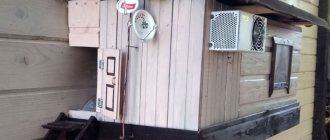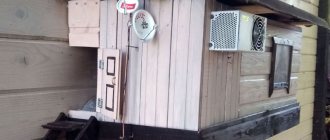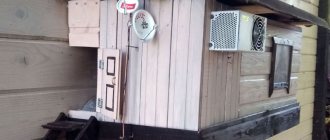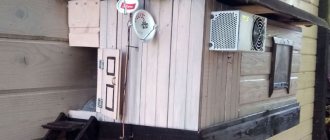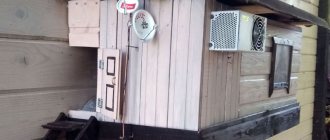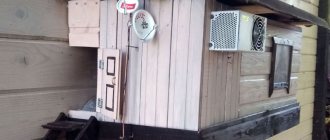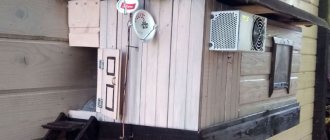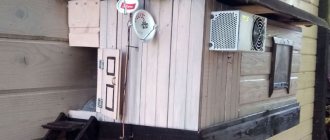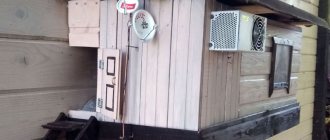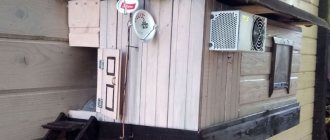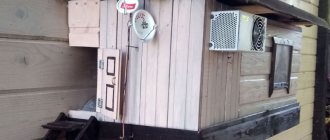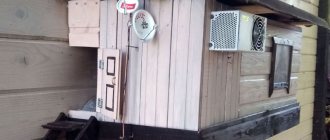Another homemade product for those who are bored at home
I needed a couple of antennas for digital, in places with “not the best reception”... I went shopping (this was before self-isolation - if it’s relatively budget-friendly, then it’s complete G. The more expensive one looks decent, but how it works is questionable.
- if it’s relatively budget-friendly, then it’s complete G. The more expensive one looks decent, but how it works is questionable.
I decided to make something homemade. It was somehow awkward to “twist” an antenna from a piece of cable (although rumor has it it works) - I wanted something simple, but more decent and advanced
In fact, the one I made is not radically more complicated, but somehow more “solid” or something. And the results of its testing were very encouraging, so I decided to sketch out a short description of what and how, in case someone else finds it useful 
... even if my street cats have a “normal” antenna on their house, what can you do without an antenna?!
The wire is not all finished yet, now we’ll assemble something!

In the places described, I previously used home-made broadband log-periodic antennas, probably since the “beginning of perestroika.” They worked well in analog and not only on UHF, but “for some reason, digital was too tough for them.” I didn’t really delve into the essence of the reasons, I removed them and began to think about what to replace them with. Here is one of them, waiting for a place in the trash
They worked well in analog and not only on UHF, but “for some reason, digital was too tough for them.” I didn’t really delve into the essence of the reasons, I removed them and began to think about what to replace them with. Here is one of them, waiting for a place in the trash
A little history
In the early 60s of the last century, our compatriot Kharchenko K.P. developed a simple flat zigzag antenna with good characteristics.
Copyright certificate No. 138277 for an invention called “Band directional antenna” was issued to Konstantin Pavlovich Kharchenko in 1961 (according to his application dated June 16, 1960). In the same year, materials were published in the magazine “Radio” for repetition by radio amateurs.
The antenna is not critical to materials and dimensions during manufacturing, has a simple good match with the reduction cable, and it successfully combines multiple elements of a common-mode antenna array with a single feed point.
Theory and calculations
The described antenna, in theory, has a horizontal “figure-of-eight” radiation pattern and a relatively high gain, which can be further increased by using a reflector/reflector.
To obtain maximum gain on all channels, it is necessary to make an antenna approximately in the middle of the range between the multiplexes used.
Finding (for calculations) the frequencies of multiplexes used in your region is easy,
for example, a request like “dvb-t2 channel frequencies” + “Krasnodar”
I found something like this:
The middle, between “my” two multiplexes, is 700 MHz - we will calculate the antenna at this frequency.
As a basis for calculating the dimensions of the antenna, we take the drawing of its author
Calculate the wavelength: λ = 300 / f [m]
300/700 = 0.428m, approximately 43cm length of each side of the rhombus
λ/4
=43/4= 10.75
The total length of the material we need (11cm*8=88cm) is less than a meter. The distance between the reduction contacts, where we will solder the cable, is 10-12mm (the standard value for this antenna for frequencies below 900 MHz).
I will make a simple antenna, without a reflector, however, to further increase the gain of this antenna, it is quite possible to install it behind it
for example, from a metal mesh/grill, foil material or simply a metal plate. Its dimensions should be approximately 20 percent larger than the dimensions of the antenna and it should be located at a distance of ƛmax/7. For my case: wavelength (channel 39) 300/618, it turns out...49/7= that is, about 7cm
For those who are too lazy to do the calculations themselves
— you can use an online calculator, the results will differ only slightly from those I received. Here, for example, this one - here you immediately enter the frequencies of two multiplexes and get the dimensions of the antenna (without a reflector) Or another option, with a reflector - I really want to note that in the second option a slightly different calculation option is used, different from the author’s. An antenna with angles other than 90° is assumed and the reflector distance is calculated as λ/8
To make the antenna sheet, it is recommended to use aluminum or copper (copper is easily soldered) with a diameter of 3 mm and higher - the larger the diameter, the more broadband the antenna is. You can use tubes; the thickness of the walls is not important, since only the surface of the material is used (in fact, you can wrap any dielectric with foil to obtain the required material). However, in my opinion, the easiest way is to buy a meter of large-gauge copper wire at an electrical supply store.
The best TV antennas for a summer residence with an amplifier for 2021
Remo "Kolibri-A-DX Deluxe"
Supports digital and analog signal reception. A successful design solution allows you to find a signal even in the area of not direct visibility of the television tower. Due to its compact size, it can be installed even indoors.
Remo "Kolibri-A-DX Deluxe"
Advantages:
- low cost;
- easy setup and installation;
- The quality of the materials is not satisfactory.
Flaws:
- many users note that this model does not pick up the signal well;
- inconvenient amplifier adjustment;
- inconvenient fastening;
- short wire.
LOCUS ZENIT-20-AF
The active steel model of the Zenit series ensures reliable TV reception even in places with poor coverage. The digital index in the name indicates the number of vibrators on the device. Only 5 V is enough for power. This means that it can be supplied from the tuner; installation of a low-voltage unit is optional. The receiver for external external mounting can withstand temperature fluctuations from -40 to +40 degrees. The maximum permissible distance from the television tower is 45 km.
Fastening to the mast is carried out using a bracket. There is also a pin located there for greater ease of installation.
LOCUS ZENIT-20-AF
Advantages:
- reliable signal reception;
- built-in amplifier;
- does not require additional installation of a power supply;
- low cost;
- compact size.
Flaws:
- Some users have complained that they only receive 10 channels.
BBK DA32
The stylish active outdoor BBK DA32 picks up almost all generally accepted television and radio broadcast signals (DVB T2, DVB T, DAB, ATSC, DMB-T/H, ISDB-T). Can be attached to any type of surface. The model is equipped with a low noise amplifier and a gain of 32 dB. Such indicators allow you to obtain high-quality images under any conditions.
BBK DA32
Advantages:
- attractive appearance;
- moisture-resistant housing;
- permissible distance from the tower is 50 km;
- fasteners are included in delivery;
- easy to install.
Flaws:
- not available for purchase everywhere;
- too easily soiled, over time the white color may turn yellow;
- no coaxial cable;
- A working power supply is required for efficient operation;
- one bracket for mounting on the mast.
"MERIDIAN" 07AF TURBO
The main part of the design of models from the Meridian series is made of aluminum. Additional elements are made of steel using a special technology, which consists of powder and galvanic coating. It prevents corrosion. The turbo prefix means that it is equipped with a patented balanced amplifier, which improves reception performance in comparison with similar competitor models. As a result, the consumer receives a higher quality image on his screen.
"MERIDIAN" 07AF TURBO
Advantages:
- low cost;
- compact design with a high degree of rigidity;
- the distance to the broadcast center can reach up to 70 kilometers;
- compact dimensions;
- high-quality assembly.
Flaws:
- The amplifier requires power supply from the TV.
GAL "Super-Dachnik"
The model from Galax receives digital and analog TV signals in the VHF FM UHF DVB T/T2 range. The amplifier brings the level to 36 dB. The antenna is made of steel with a polymer powder coating applied to it. Due to the latter, it will last for a long time even under the most unfavorable conditions. The kit includes an amplifier, power supply, 6 m cable, various fasteners, accessories and documentation.
GAL “Super-Dachnik”
Advantages:
- assembly and installation is easy to understand;
- not sensitive to temperature fluctuations and high humidity;
- high-quality packaging;
- available for purchase even in hypermarkets.
Flaws:
- Self-installation is complicated by the dimensions and weight of the model.
REMO Groza
It is a good solution for rural areas, where, as a rule, the reception area for digital and analogue TV is not reliable. The anti GSM filter successfully suppresses the signal from base stations at the amplifier input. The maximum distance from the tower is 60 km. Durable aluminum alloy was the main material for manufacturing. Able to withstand sudden temperature changes and high humidity.
REMO Groza
Advantages:
- collapsible design allows transportation with maximum comfort;
- fastening elements are included in the delivery kit;
- The set includes a USB injector for power supply from the TV;
- assembly will not cause problems even for a beginner.
Flaws:
- cables and bracket are purchased separately;
- the box in which the amplifier is placed needs additional sealing;
- Questionable quality of soldering of connectors for connecting to the TV and power elements.
Cadena AV-9018BO
According to the developers, one of the most resistant to variable weather conditions is an outdoor model with a built-in amplifier. Reliable protection from negative influences is provided by a durable, moisture-resistant, stylish black case. A durable coating protects parts from exposure to UV rays. It is possible to directly install the model on a wall or on a mast for more reliable reception.
Cadena AV-9018BO
Advantages:
- support of various signal types (VHF FM UHF DVB T/T2);
- impressive design;
- amplifier noise is 3 dB;
- the set includes a bracket;
- Packing made of thick cardboard.
Flaws:
- network adapter required;
- Unsure signal reception in bad weather.
HYUNDAI H-TAE220
A budget street model with a built-in amplifier has proven itself to be one of the best in its price segment and even among antennas that are much higher in cost. A broadband passive device is capable of receiving information from a repeater located 75 km away. This is a decisive factor in deciding what to choose. In this case, the maximum gain is 15 dB. It operates in the frequency range from 470 to 862 MHz with the ability to receive analog and digital signals.
HYUNDAI H-TAE220
Advantages:
- affordable price;
- compact dimensions;
- ease of installation;
- made of quality materials.
Flaws:
- not found.
Antenna assembly
Let's remove the insulation from a piece of wire one meter long.
I got a wire with a diameter of 4.5mm
The tools you will need are a vice and a hammer. Measure approximately 11cm each and bend at an angle of 90°
The end result is to get such a “geometric” figure 
We cut off the excess and solder the ends. It should look something like this...
Solder the cable as shown in the photo.
We lay the cable along one side of the square and secure it with clamps. This arrangement of the cable is necessary for its coordination (there are different opinions, not everyone agrees with this statement).
When using a reflector, the antenna sheet at the extreme points of the squares can also be secured using metal stands, for example, soldered onto the remains of the same copper wire - there are points with zero potential (highlighted in green). In other places, fastening is allowed only through a dielectric.
Tests
And finally, a performance check and a rough
assessment of the quality of the resulting antenna.
In fact, everything is simple with the test - turn it on, it works! And to evaluate whether the game was “worth the candle,” let’s compare the parameters of the received signal from the manufactured antenna with the one I’m already using at the dacha, with a declared gain of 11dBi
And to evaluate whether the game was “worth the candle,” let’s compare the parameters of the received signal from the manufactured antenna with the one I’m already using at the dacha, with a declared gain of 11dBi
The antenna is installed in the attic of a country house, at a distance of approximately 16 km from the tower.
Signal level: factory stationary antenna on the left / homemade on the right
At first glance, the difference is only 1% (95 versus 94) - but this is not a completely correct comparison, since my external antenna is connected through a splitter, which further weakens the signal.
comparison table
| Name of product | UHF frequency range | Gain level indicator | Dimensions |
| Locus L 941.10 CAYMAN | 470-860 MHz | 11-18 dBi | 268x300x85 mm |
| HARPER ADVB-2969 | 470-862 MHz | 30 db | 150x150x203 mm |
| Selenga 101A | 174-862 MHz | 33.0 dBi | 190x110x8 mm |
| REXANT RX-267 | 470 – 862 MHz | 26 dBi | 270x350x120 mm |
| HARPER ADVB-1420 | 470-862 MHz | 30 dB | 183x234x130 mm |
| REMO BAS-5340-USB TVJET | 470 – 862 MHz | 23-43 dBi | 270x350x120 mm |
| Ritmix RTA-101 AV | 470 – 862 MHz | 32 dB | Length 600 mm |
| REXANT RX-107-4 | 47-220 MHz | 2.5-5 dB | 30x80x350 mm |
| Ritmix RTA-001 | 470-862 MHz | 5 dB | 350x80x30 mm |
| D-COLOR DCA-109 | 40-862 MHz | 5-7 dB | 60x260x60 mm |
Assessing the performance of the antenna
Let's try to make a more correct comparison by connecting through the splitter input.
Well, in addition, for clarity, let’s add the number of participants List of antennas taking part in the comparison:
1. External antenna Funke BM 4551 external long-range,
declared gain, from some sources (bought at Yulmart), up to 16dB
2. There is an old UHF loop antenna, from TV Electronica 313d, I must say, despite its simplicity, it’s a very good antenna, that’s why it’s been preserved 
3. I went to the store and bought for comparison in the review one of the cheapest, such as a symmetrical vibrator (100% the most purchased by pensioners, due to the low price).
I will carry out all “measurements” at one point, located as close as possible to the external antenna - its location was experimentally selected based on the maximum signal, so we can say that the conditions are approximately the same
So, we have already seen the signal level from the external antenna at 95% (at the time of current measurements it showed 94%), we take it as a standard. All comparisons are made by connecting antennas to the input on the splitter, to which an external antenna is usually connected.
Loop antenna, from Electronics 82% on 39 multiplex and 66% on 60
Budget with “horns” - 62%/38% (on the verge of losing the broadcast)
- 62%/38% (on the verge of losing the broadcast)
Double square - 92% on both multiplexes, about a couple of percent less than the external one
Out of curiosity, I decided to check the work of the reflector, which is easy to make from any metal mesh, plate or even foil... It REALLY works noticeably! The level rose to 96%!, which is even higher than the stationary one, with a declared gain of 11dB.
The most interesting thing is the object that I used as a reflector! 
There was no foil in the house; the only thing available with a metal surface of the required size was... a laptop cover (I have a metal case). But the main thing is the result! It’s clear that I’m not going to “tie” the laptop to the antenna, and its amplification is enough for me without a reflector
What could be causing the signal to deteriorate?
The receiving device must be placed away from metal structures at the maximum permissible height. If you draw an imaginary line from it to the repeater, it should not bump into any obstacles. The iron roof of the house acts as a source of interference.
When laying the cable, follow a number of simple recommendations:
- It is forbidden to use a cable that is more than 5 years old;
- low quality cheap products are not acceptable, they are practically devoid of braid;
- shortening the cable as much as possible only causes harm;
- there should be no sharp creases;
- It is forbidden to put excess wire in a bay.
Conclusion:
I can confidently recommend repeating it!
Simple, “cheap and tasty”... One of the simplest, indoor antenna mounts... with ordinary suction cups - if you’re lucky with the direction to the television center
The next antenna "recommended for repetition" is... log periodic
“Crazy hands” were with you. Good luck and good mood to everyone! ☕
Good luck and good mood to everyone! ☕
